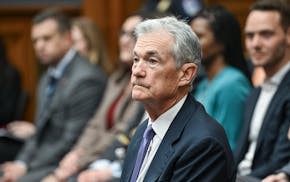Retirement-age Minnesotans are enjoying the rewards of this era of "full employment," with more holding jobs while also working more hours and earning higher wages, according to state data.
The over-65 population is already expanding rapidly, with some 10,000 baby boomers reaching retirement age daily across the country. So the fact that this group accounts for a growing share of the workforce makes sense, said Oriane Casale, assistant director of the Labor Market Information Office in the state Department of Employment and Economic Development (DEED).
But the share of Minnesotans 65 and older in the workforce has increased nearly 63 percent since 2003, Casale said. They held 4.4 percent of jobs covered by unemployment insurance in 2016, the most recent data available, up from 2.7 percent in pre-recession 2003. The average number of hours they have worked has gone up 20 percent over the same period.
Even more telling of the group's rising standing: Those of retirement age who still work are making more money. Their average hourly wages increased 55 percent from 2003 to 2016, from $10.11 to $15.63 an hour, Casale said. That's a bigger raise than workers 55 to 64 and the overall workforce.
"It's easier to find work no matter who you are," Casale said, noting the state's overall October unemployment rate of only 2.8 percent. "But certainly this data is supporting this notion that older workers are definitely benefiting from the tight labor market."
Encore adulthood
The strong economy is creating new opportunities for older workers as many re-examine this time in their lives, said Kate Schaefers, AARP Minnesota volunteer president.
"People in their early 60s or late 50s or even into their 70s aren't necessarily saying they want to be fully retired," Schaefers said. "People are exploring a lot of different kinds of work and wanting that work to fit with what they're wanting at this life stage."
For many, though, money is driving their decision to stay in the workforce. Nearly 90 percent of "experienced workers," or those 50 and over, say they work because they need the money, Schaefers said, citing the AARP's "Value of Experience" survey released in July. Meanwhile, 84 percent are still on the job because they need to save more for retirement. More than three-quarters said working makes them feel useful, while 83 percent simply enjoy their job.
"Many people have not saved adequately for a 20- to 30-year retirement," Schaefers said. "But they're also working because they enjoy what they're doing or they see work as an enrichment in their life as well."
Offering a new opportunity for "transitional boomers" considering new careers or other meaningful engagement is the University of Minnesota's Advanced Careers Initiative (UMAC), a yearlong fellowship for people 55 and older that launched last year, said Schaefers, who also is UMAC's executive director.
"They're looking at [retirement] very differently from previous generations," Schaefers said of those exploring options in what UMAC founding director Phyllis Moen, a sociology professor at the U, refers to as "encore adulthood."
"It's not just a one-time thing," Schaefers said. "People are not necessarily looking for leisure retirements even if they can afford them. They're looking for something else."
Evidence of that search may show in the industries with the highest shares of workers 65 and over — which DEED's Casale said include fishing, hunting and trapping; museums, parks and historical sites; and membership organizations and associations. Those roles may be "more of a hobby or maybe a part-time job that's more for fun than anything else," Casale said.
'Slight uptick' in discrimination
While the tight job market is benefiting older workers, Minnesota Department of Human Rights Commissioner Kevin Lindsey said his office has seen a "slight uptick" in the number of employment claims based on age discrimination.
Lindsey attributes that increase in part to the older population making up a larger share of the workforce. Downsizing, in some cases resulting from automation, is also playing a role.
The most common violation occurs when employers ask "How old are you?" or other questions designed to elicit a job applicant's age, Lindsey said. Such questions are a violation of the Minnesota Human Rights Act, Lindsey said, and can serve as evidence to support an age-discrimination claim under federal law.
Widespread age discrimination did not turn up among employers Lindsey investigated for asking such questions. A significant number, however, used applications that asked when an applicant graduated from high school or college — a question that he said is illegal under Minnesota law. Asking whether an applicant has a degree or diploma, however, is appropriate if it's relevant to the job, he said.
Labor and employment attorney Sara Gullickson McGrane said she has not seen a change in age-based employment discrimination claims in her practice or as board chair of Mid-Minnesota Legal Aid. People have an easier time finding other jobs now, which could lead to fewer claims.
If anything, age now may be a plus for some older workers and job seekers, McGrane and others said.
"When we're talking to clients looking for replacements, a lot of times they are looking for those people who have been through a lot," McGrane said. "For those older workers it's a good opportunity because we do have a lot of clients who have a need for their skill set and that's something that I don't think they've enjoyed before. That's a real benefit for our older workers."
Todd Nelson is a Lake Elmo-based freelance writer.
Trump trial: Why can't Americans see or hear what is going on inside the courtroom?
Biden visits his Pennsylvania hometown to call for more taxes on the rich and cast Trump as elitist
Business boom: Record numbers of people are starting up new small businesses
Participant, studio behind 'Spotlight,' 'An Inconvenient Truth,' shutters after 20 years
